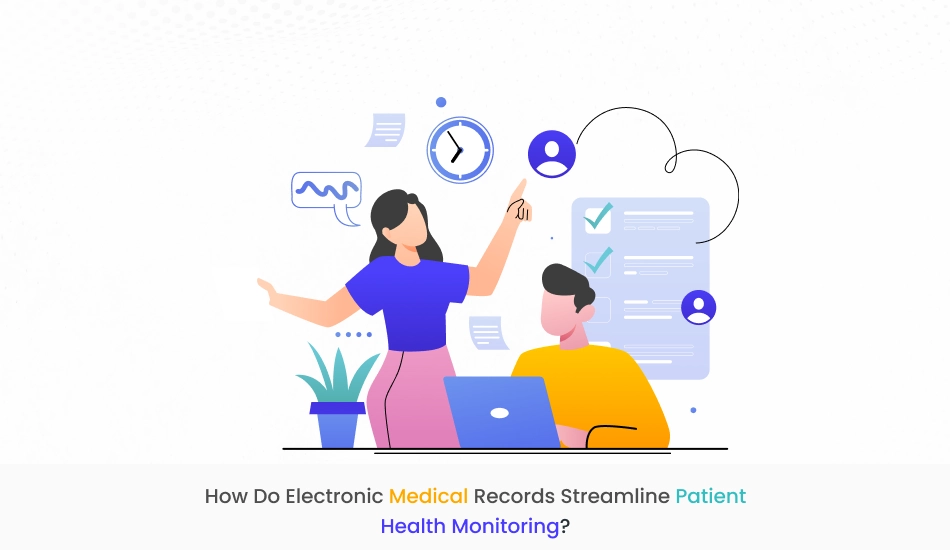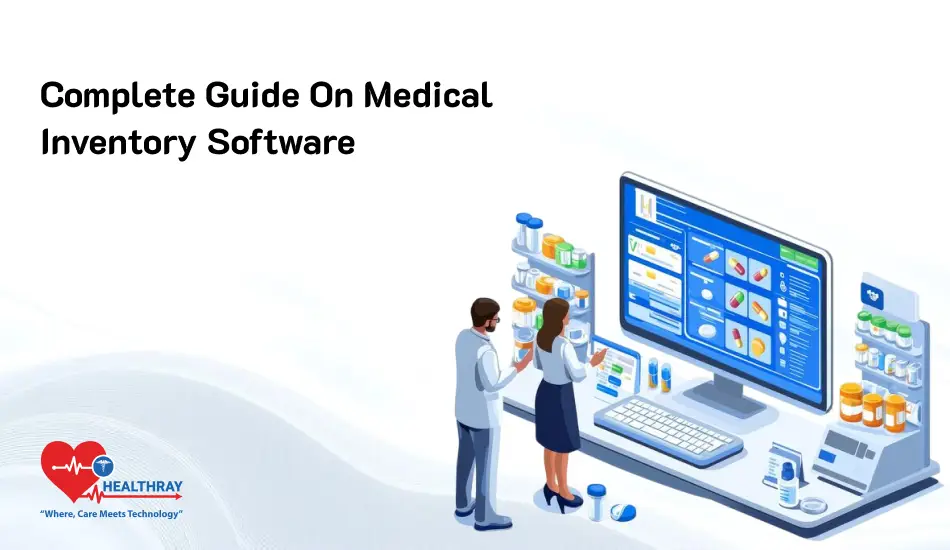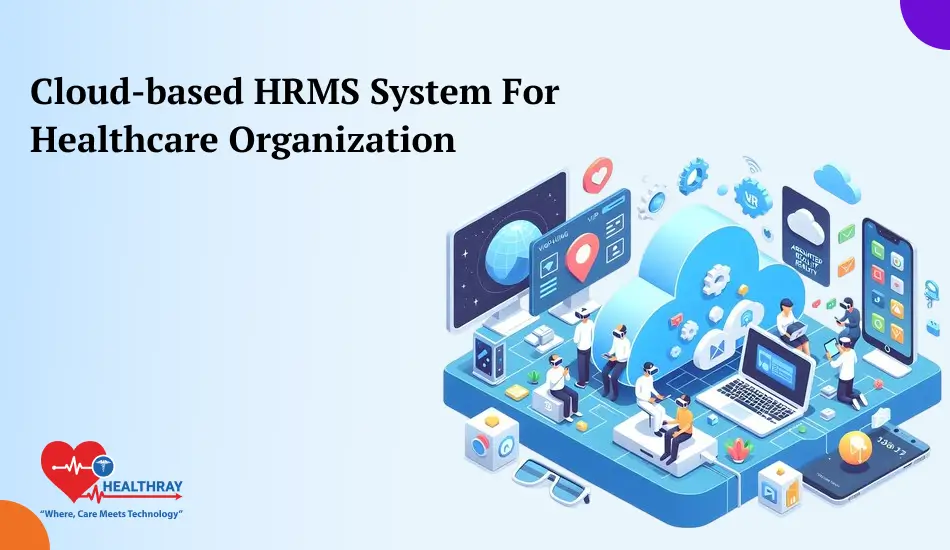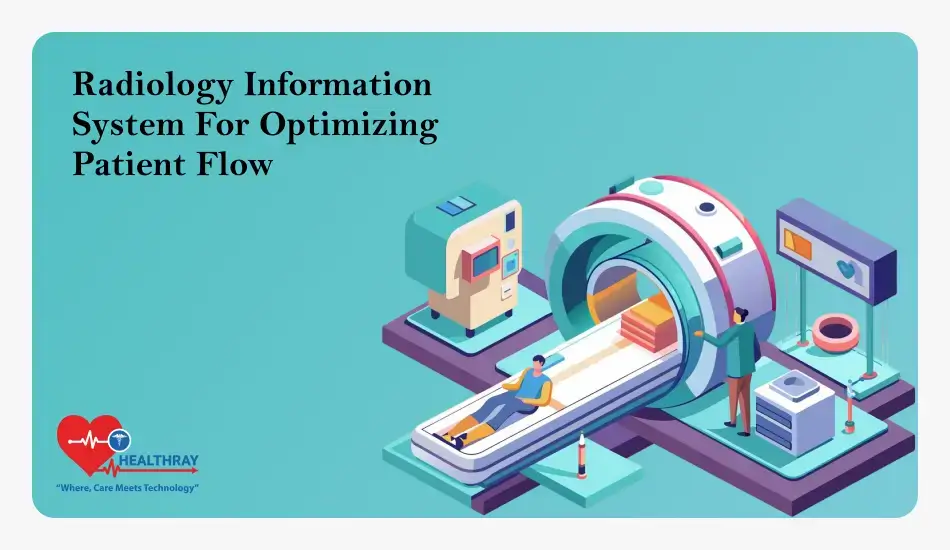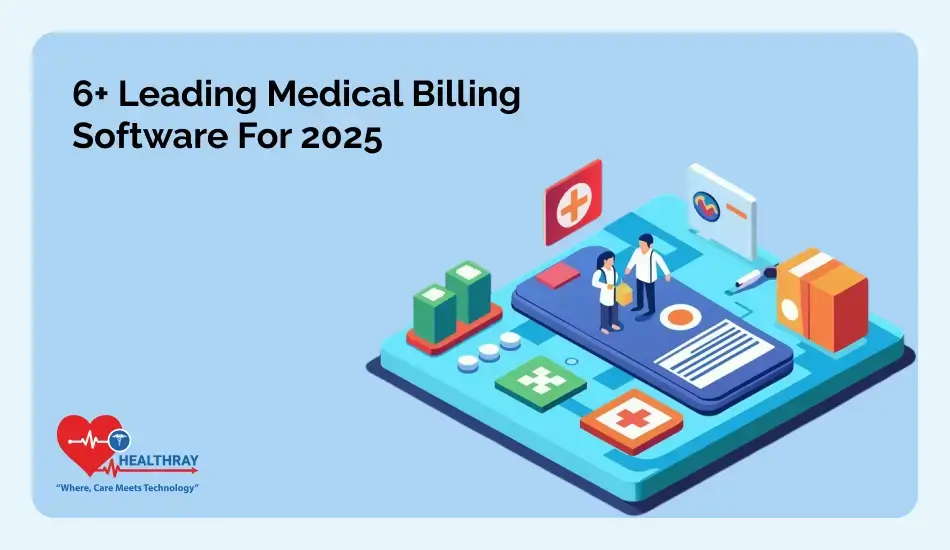Quick Summary
Electronic medical record for presenting entire hospital and patient information in digital format. It eliminates paper requirements, reduces manual error, and provides a user-friendly interface for simplifying medical work. As a result, it consolidated patient information with demographic details and improved teamwork among medical practitioners.
Supports remote monitoring of patients’s health, which improves the reach of medical care from urban cities to remote and rural areas. Also, it provides feasibility for managing chronic conditions.
Introduction
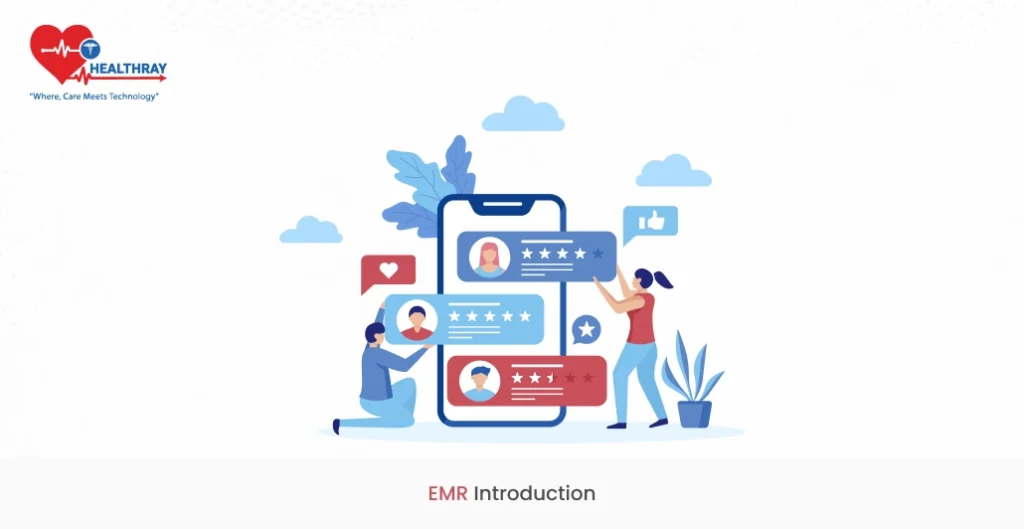
The electronic health record has a vast capability to record hospital transactions and a large database that supports recording the medical history of individual patients in ledger format. It is feasible for medical staff to enter patient details and maintain their documents in digital format, leading to smooth clerical tasks with minimal error-proneness.
This platform organizes medical transactions in a structured way to decrease training expenses. Moreover, it transforms medical data into graphical reports that are easy to interpret, leading to a faster recovery of chronic diseases.
Furthermore, health-care providers can monitor patients’s health from any location and aid in accurate analysis through error-free medical records. Electronic medical records effectively share medical documents and reports with any health care specialist.
Provides inter-departmental coordination, which increases revenue income through expanding medical services. Enhances patient safety through accurate analytics and alerts while entering incorrect dosages. It incorporates a medical dictionary that supports understanding difficult medical terminology. Also, it helps junior staff understand medical reports easily.
With the electronic medical records software, it creates a new shape of a healthcare industry and improves associated facilities such as instantly contact with the healthcare expert, improves healthcare innovation, enforces clinical regulations, and creates consolidated reports, which alleviates drafting a business decision strategy. Furthermore, the EMR software captures historical documentation, enhances security, precise treatment decisions, and reduces duplicate tests. Improves the work quality, increases healthcare efficiency, reduces hard efforts, and minimizes expenses.
Role of Electronic Medical Record in Redefining healthcare

With an electronic medical record, it is easy to automate medical operations that require less human intervention. Healthray’s EMR software has been designed to overcome health care challenges, which are more prevalent in the current landscape.
It maintains real-time patient data and is a leading tool for decreasing expenses and preserving natural resources. Let’s dive deep into the detailed role of EMR software in redefining health care:
Improved Healthcare experience
Electronic medical record systems accumulate patient data that includes patient registration information, allergies, symptoms, radiology records, and progress notes. This information is used to track the patient’s progression. Consequently, it enhances patients’ care and takes their satisfaction to the next level.
It structures hospital and patient data in a structured way, making it easy to get the required and concise information in a few clicks. Automatically, it prepares medical reports in different graphical formats, such as pie- charts, tabular reports, and bar graphs. Consequently, it eases the process of analyzing reports and helps in achieving faster hospital goals. Obviously, it’s difficult to maintain a hard copy rather than a soft copy.
Electronic health records foster digital radiology images such as MRI, CT scans, and X-rays. It reduces hospital expenses that are incurred in preparing physical documents and radiology images. Preparing physical radiology images requires lots of healthcare staff effort and involves cumbersome processes. Moreover, it enhances medical departmental coordination and aids in faster treatment
Remote healthcare accessibility
Electronic medical records provide digital access, which helps health care providers monitor patient health at any time and is able to handle critical cases. It makes it easy to manage critical diseases, and patients also have access to their medical reports. Consequently, it develops enthusiasm in patients regarding their health and maintains their health on a continuous basis.
Facilitate interoperability by creating an environment of open communication between medical professionals and patients. This widened medical accessibility at a broader level, regardless of their location. Mainly, it benefited the rural population, elderly people, and disabled people. Moreover, it increases patient care. Look below at the at the various advantages of remote healthcare accessibility:
Smoother Clinical Tasks
Managing clinical tasks is prominent in hospital management as it incorporates various medical departments such as the financial department, administrative department, and nursing management department. Also, managing human resources is part of it. The electronic medical record simplifies appointment booking tasks and aids in focusing more time on healthcare goals.
With health information technology, it is easy to satisfy healthcare staff and measure their job performance with their assignment details. Moreover, this is a more powerful tool, as entire health care departments can save their time and focus more on patient health. Also, Electronic Medical Records (EMR/EHR) solutions enhance patient satisfaction by providing personalized care.
There are several activities occurring each day such as maintaining documents, storing crucial details, information has been presented in the correct manner, collecting medical amounts, crafting a multiple variety of forms, and applying legal protocols effectively. Furthermore, the EHR software assists to plan resources, calculate salary amounts, and monitor information efficiently. Therefore, it avoids delays in treatment and medical error.
This simplifies the tasks of fetching medical records and sharing them with different departments, such as the accounting department, the diagnostic department, the surgical department, and the customer services department. Therefore, it eases the work of all types of specialists, whether they are endocrinologists, oncologists, dermatologists, and more.
Step towards digital era with our healthcare solution
Revamp your hospital facilities and embrace change for better healthcare management. Ease in managing and organizing large medical datasets leads to effective analysis. Seize the opportunity now!
Data Management :
Electronic Medical Records collects hospital department data and patient data on a single platform. Doesn’t that sound amazing? One software and all medical data are in your palms. Not only recording data. Also, organized data in structured format with concise medical reporting that can be interpreted easily by any medical provider.
Patient data encompasses patient information with demographic details, symptoms, and allergies. Also, include their lab test results and radiology images. Centralized data assists patients in drafting their financial medical budget. Healthcare providers know their annual revenue and, accordingly, make financial strategies for increasing hospital infrastructure.
In the traditional healthcare system, it is difficult to manage medical data in a systematic manner and accumulate patient information about their medical history, vital signs, and symptoms. In contrast, electronic medical records can manage patient information and also depict information in a concise manner for better medical treatment.
Electronic Health Record For Safeguarding confidentiality
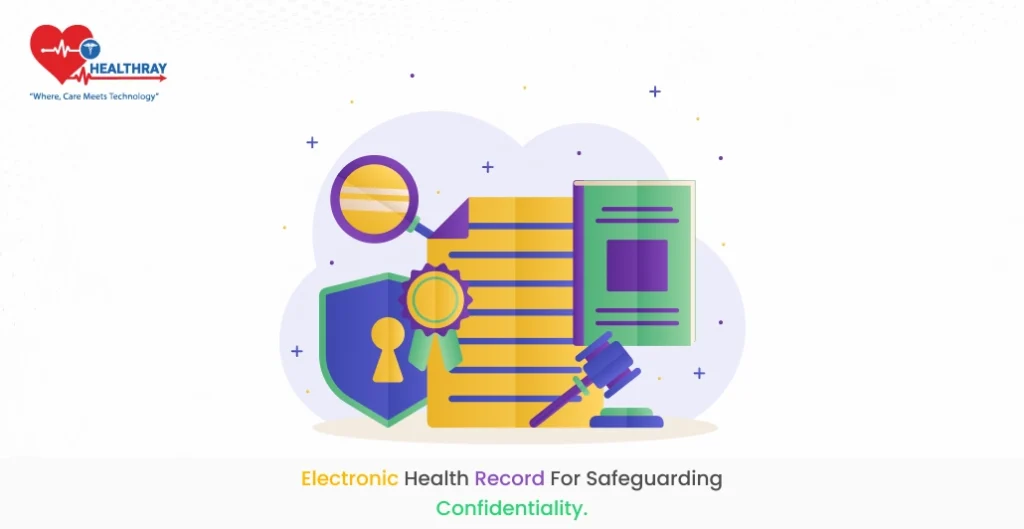
The electronic health record plays a fundamental role in precise treatment and provides robust security to maintain patient safety. It provides a patient platform with a systematic framework of better and clearer information. Maintaining patient safety is the primary goal for every healthcare organization. Electronic health records follow various mechanisms to protect patient and hospital data:
Restrict access
Electronic medical records have vast hospital information about patients’s medical histories and their current medical documents. Secure data is more important in the era of cyber attacks.This platform has access to limited authorized healthcare providers. Automatically, it restricts access to unauthorized users.
This platform supports sharing medical records with other healthcare specialists with the user’s permission. Always consider a platform that adheres to security protocols, like Healthray. It is the best EMR software for securing patient documents and delivering the best healthcare technology service. This takes patient satisfaction to the next level.
Meeting healthcare regulations
It’s crucial to follow healthcare regulations to maintain patient privacy and reduce hospital expenses. It is troublesome for healthcare providers to follow the entire regulations. Most hospitals don’t have enough time to adhere to medical rules. Sometimes, they initially follow, but maintaining and updating hospital information is much more difficult as it requires more time.
Electronic medical records maintain patients’ privacy by applying strict measures.Consequently, it can prevent cyberattacks and manipulate data for different uses. The benefits of compliance with healthcare regulations, such as:
- Protecting a patient’s medical records
- Increasing patient faith.
- Fast recovery of disease.
- Enhanced health outcomes.
- Reduces legal costs.
Data encryption
Data encryption processes convert entire records into code while conducting financial transactions or sharing medical documents with healthcare professionals. Medical records are viewed and shared by the individual who is authorized. Consequently, it supports protecting patients’ private information and their medical images.
It prevents stealing medical data and using that information for the wrong purpose. Our platform always uses asymmetric encryption, as it provides more security than symmetric encryption. It is paramount to protect patient and hospital information from cyberattacks. Also, it maintains privacy and makes the information confidential until receiving patient consent.
It reduces the risk of manipulating the documents and eases the sharing of documents from any location. This reduces downtime, and medical operations continue without any obstacle. Builds patient trust and their confidence in healthcare providers. Therefore, it ensures adherence to healthcare regulations.
Robust Authentication Security:
Traditional healthcare systems incur more expenses to protect patients’s data and hospital information, requiring warehousing and cabinets with proper locking systems. There is always some risk of forgery, theft, or lost medical information, even when there are strict security measures. Digital medical security can’t be measured with traditional healthcare security.
Digital measures provide double-factor authentication and persistent notification regarding the use of login credentials by another party. Electronic health record platforms won’t take simple passwords; there is a strong password requirement.
It facilitates remote access, which leads to prompt action and users receiving alerts from any location. Consequently, it supports protecting patient’s medical records and reduces the risk of misuse of medical information.
Elevating Health Outcomes with Patient Monitoring
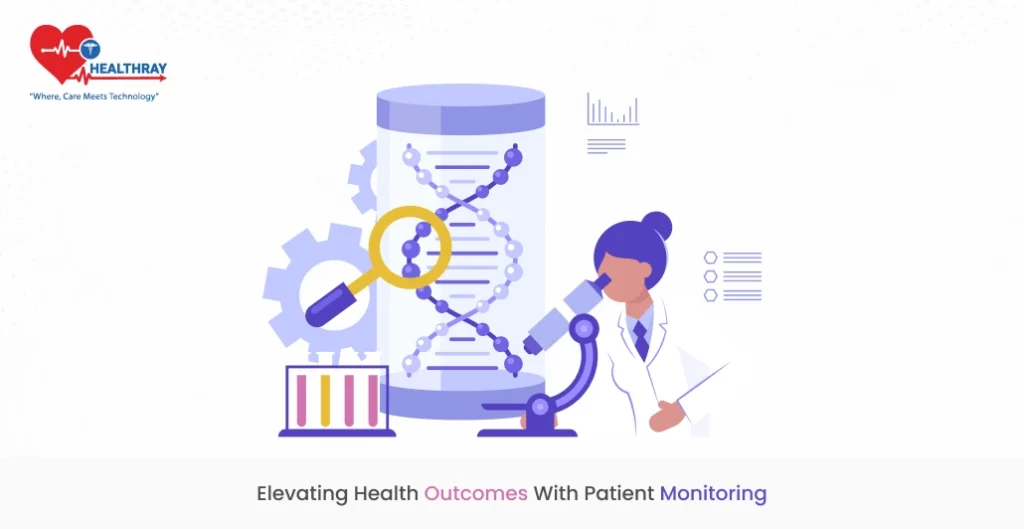
Electronic health records simplifying healthcare work from managing administrative departments to measuring increment amounts. This software saves patients time and simplifies medical complications. Electronic medical record systems provide the facility of virtual monitoring. Doctors can treat patients as per their convenience and are able to detect any deviation in the patient’s health.
This platform is best for medical research and makes it easy to detect critical conditions from anywhere. With an electronic health record, it is easy to have a digital medical shop without additional property and other investments. It supports expanding medical facilities on a large scale. Therefore, it lowers patients’s expenses, such as transportation and accommodation costs.
Electronic medical record systems have a wider capacity, which can detect critical conditions at an early stage and aid in taking proactive actions. Also, it effectively manages chronic diseases such as hypertension, thyroid conditions, heart rate, etc. Consequently, it improves patient health outcomes and assists in a speedy patient’s health recovery.
Conclusion
Electronic health records are the leading solution for recording medical transactions. It enhances the health experience, expands healthcare accessibility, and smooths clinical tasks, reducing patient and hospital costs. Managing healthcare and patient data with a computerized system. Consequently, it supports maintaining data integrity, increasing patient engagement, and reducing operational costs. Furthermore, this is the best tool to address healthcare challenges and drive the societal transformation of how people perceive medical services.
